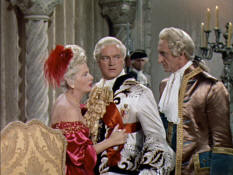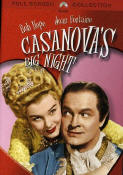Casanova's
Big Night
|
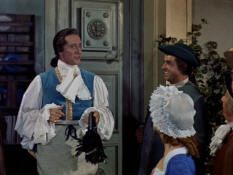 Lucio (Casanova's valet) greets the creditors who have come for their payment. |
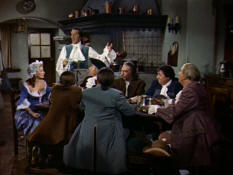 "Senor Casanova will be up shortly," he assures them. |
The mission is for Casanova to seduce Dona Elena, a young woman of Venice who is engaged to be married to the son of the Duchess. The Duchess wants to test Dona Elena to make sure she is worthy to join the family. As proof of his success, Casanova is to bring back a petticoat embroidered with the Duchess' family crest, a gift from the titled lady to the young bride-to-be.
Young Elena's family complains to the Doge of Venice about Elena's virtue being questioned. The Doge feigns outrage, but secretly he wants Casanova to succeed in seducing Dona Elena. The Duke will then cancel the wedding, which will be an insult to Elena's family and all of Venice. That will give the Doge an excuse to attack Genoa.
Many amusing situations arise as Pippo the fake Casanova attempts to steal the petticoat. In the end, he hasn't the heart to ruin Elena's reputation. In so doing, he gains Francesca's respect. Lucio ends up being black-hearted, as he steals the petticoat to get the money from the Duchess, and then intends to keep the money for himself, instead of sharing it with the tradesmen whom Casanova had not paid.
A unique aspect of the film is that it offer two different endings: One in which Pippo dies, and another in which Pippo lives and is a hero. Hope asks the audience to choose which ending they prefer by holding up either their candy bars (for the "death to Pippo" ending) or their popcorn (for the "Pippo the hero" ending). He then says, "What's the matter with this theater? Don't they sell popcorn?"
| "Casanova's Big Night" with Bob Hope, Joan
Fontaine and Basil Rathbone Although Bob Hope romps through this Technicolor costume comedy in a way that should amuse his avid followers, it is doubtful if those who can either take Hope or leave him will find the picture much more than moderately entertaining. As a cowardly tailor's apprentice who impersonates Casanova, the great lover and expert swordsman, Hope makes the most of every opportunity to garner laughs from the numerous whacky situations in the zany story, but there are moments when his slapstick antics are forced and quite feeble. The best of the comedy highlights include Hope dancing a gavotte at a palace ball while dressed as a woman; his duel with a champion swordsman; and his arrival in a gondola in Venice, where adoring women throw roses at him and scream in bobby-sox fashion while he sings a love song. The production values are fairly lavish and the color photography good. Along with several other tradesmen, including Joan Fontaine, a grocer's widow, Hope, a tailor's apprentice in the Italy of 1757, arrives at the villa of Casanova (Vincent Price), who had promised to settle his long overdue accounts. Having no intention of paying his bills, the great lover talks the unwitting Hope into changing clothes with him and absconds from town. Just then Hope Emerson, a Duchess, arrives at the villa with Robert Hutton, her son, and mistaking Hope for Casanova, offers to pay him 10,000 ducats to test the love of Audrey Dalton, Hutton's fiancée. As proof of his success, Hope is to bring back a petticoat embroidered with the Duchess' family crest, a gift from the Duchess to the young bride-to-be. Hope first objects to the masquerade, but quickly agrees when Joan, for whom he had a great desire, hints that she will be receptive to his advances if he undertakes the assignment. Accompanied by Joan and by Basil Rathbone, Casanova's valet, who, too, hadn't been paid in months, Hope arrives in Venice and makes his way into Audrey's bedroom. Before he can make love to her, he is trapped by the male members of her family but manages to escape. Paul Cavanagh, Audrey's father, asks Arnold Moss, the tyrannical ruler of Venice, to banish Hope from the kingdom, but the scheming ruler, who had been plotting to seize Genoa, plans to use Hope's mission as an excuse to start a war. He explains that if Hope is successful and Hutton rejects Audrey as his bride, the incident would be construed a san insult and serve as a reason to provoke a war. From then on Hope becomes involved in a series of whacky court intrigues that end with his being thrown into prison and sentenced to die because of his refusal to follow through on his mission in order to save Audrey's reputation. they story then winds up with two endings, one showing Hope executed, and the other showing him besting his enemies, with the audience left to decide on which ending they prefer. —Harrison's Reports, March 6, 1954 |
With the working title Mr. Casanova, work on the film began in July 1953. Paramount studios built an authentic, full-scale replica of a Venice canal for key sequences in the film. More than 400 feet long (the equivalent of two city blocks), it contained 365,000 gallons of water, which was tinted blue to give the appearance of depth. the canal was in fact quite shallow. The canal's diameter ranged from 30 to 80 feet with a stone bridge crossing it at its narrowest point.
Sixteen separate buildings lined both sides of the canal, all of them accurate replicas of homes and shops of the mid-18th century period.
The canal set adjoined the private dock of a huge Italian palace, another of the many luxurious sets used in the picture. Other key sets included an 18th century prison, a tailor's shop, Casanova's home, and Joan Fontaine's lodgings.
The studio engaged Hilda Grenier, noted expert on historical pictures, as technical adviser. Fred Cavens, Hollywood's foremost fencing instructor, supervised all the dueling scenes.
There is only one song in the film, a comedy number which Hope sings as he arrives in Venice in the gondola.
The picture was Joan Fontaine's first out-and-out comedy, and her first movie with Bob Hope. It was also Basil Rathbone's first movie with Bob Hope. Rathbone and Joan Fontaine appeared together in Frenchman's Creek (1944).
Vincent Price makes a guest star appearance as the real Casanova.
Comedy highlights include a scene in which Hope dresses as a baroness and dances a gavotte with the Doge (actor Arnold Moss).
Fans of the television series Perry Mason will be delighted to see Raymond Burr in service to the Doge!
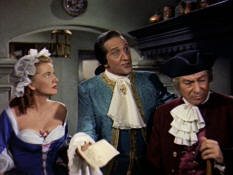 Lucio explains that Casanova has absconded. |
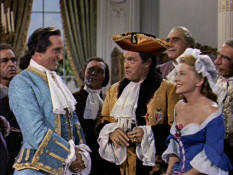 Lucio carries on the charade that Pippo is Casanova. |
The following is adapted from "Filming Hollywood's Biggest Indoor Exterior," American Cinematographer, April 1954
| One of the most lavish and expensive productions ever photographed at
Paramount studios, Casanova's Big Night is a big-scale period
comedy co-starring Bob Hope and Joan Fontaine. The photography was
directed by Lionel Lindon, ASC, veteran of some forty Hollywood feature
productions, most of them photographed for Paramount. This was one of the last pictures made at Paramount before the studio adopted the VistaVision wide-screen camera. Because the studio had not yet definitely settled on the final dimensions of the aspect ratio for its pictures, Lindon had to compose his scenes in such a manner that they would screen satisfactorily in any ratio from 1.33-to-1 to 1.85-to-1. It was the Venetian canal set where a substantial part of the picture's action takes place and where some of the most interesting photography of the picture was accomplished. For one important shot early in this sequence, the camera had to travel the full length of the canal to photograph Bob Hope's arrival in Venice. Normally, this type of shot is done with the camera on a boom or dolly but it was impossible to use this equipment in the more than three feet of water which filled the canal. Lindon solved this problem by mounting his camera on one of the U.S. Navy's rubber life rafts of World War II. To move the raft through the water, an intricate pulley and cable system was set up. However, there was still the problem of steadying the raft, and here grips wearing rubber hip boots were pressed into service to stand in the water and hold the raft steady. Later, it proved more practical to have them also push or pull the raft through the water in making dolly and travel shots. The entire canal sequence was photographed with artificial light. Where the canal extended outside the sound stage and into the outdoor set area, framework was built over it and the set entirely blacked-in—covered with black cloth to exclude daylight. this afforded more uniform control of set illumination. So vast was this set, that Lindon had to light and work on one side of the canal at a time; there was not enough equipment to light the entire set at one time at the level required. Often the camera was called upon to reach into great depths of the scene to pick up people in the distance walking along the canal sides, over the bridge, or coming in and out of buildings. Using Eastman Color negative, Lindon shot all scenes at the normal light level recommended for this film. |
| Casanova's Big Night Mild comedy with Bob Hope to give it fair b.o. chances. This is an attempt at broad comedy that misses as often as it clicks. Overall effect is very mild. Boxoffice chances, although the name of Bob Hope can be expected to help, point to fair returns only. The laughs are spotty in the Paul Jones production, coming mostly from Hope's interpretation of a meek tailor's apprentice who finds himself forced to impersonate the notorious libertine, Casanova. the costume comedy is laid in Italy back in the 1700s and rates widescreen lensing in Technicolor to show off the period trappings. The blowup in size at the preview wasn't particularly impressive since there was a noticeable lack of definition. Norman Z. McLeod's direction holds a loose rein on the antics, letting the situations run wild over the 85 minutes of footage to force as many laughs as possible. This was probably the best way to handle the frantic hoke offered in the script by Hal Kanter and Edmund Hartmann, based on a story by Aubrey Wisberg. Audience comment is invited by two endings on the film, one showing Hope being beheaded and the other having him best his enemies. Winding the plot up shouldn't have posed any problems for the writers as they have shown a tendency to blithely ignore all the other story holes. Comedy basis has Hope, mistaken for Casanova, hired by Hope Emerson, a duchess, and Robert Hutton, her son, to "test" the love of Hutton's fiancee, Audrey Dalton. If successful, he is to bring back Miss Dalton's petticoat, embroidered with the duchess' family crest. Chaperoning Hope on the love adventure are Joan Fontaine, a widow to whom he is attracted, and Basil Rathbone, the real Casanova's valet. Court intrigue is mixed in by having Arnold Moss, Doge of Venice, use the situation as an excuse to take over Miss Emerson's duchy, Genoa. Comedy is not Miss Fontaine's forte, but she manages to be a pleasant sparring partner for Hope. the others in the cast work hard at laughs, sometimes scoring. Hope's best moments include a comedy duel, dancing a gavotte while dressed as a baroness, a prison sequence with Lon Chaney, and some gondola antics while singing "Tic-A-Tic-A-Tic," cleffed by Jay Livingston and Ray Evans. Lionel Lindon handled the color cameras on the production, with John P. Fulton doing the special photographic effects. Art direction, editing and other assists are okay. Brog. —Variety, March 3, 1954 |
.
| Because the water in the canal was so
shallow that it was easy to see the bottom, it was tinted blue, which also
served a pictorial purpose as well. One of the great responsibilities of
the cinematographer when shooting color, is to keep colors consistent from
scene to scene—sometimes a problem when shooting a given sequence over a
period of days. Imagine Lindon's consternation when he arrived on the set
one morning to find that someone had accidentally dumped a quantity of
black paint in the canal, darkening the blue-tinted water considerably. As a result, production on this sequence was held up until the canal had been completely drained, cleaned, and a fresh supply of water—another 365,000 gallons of it—piped into it. Then followed the painstaking job of tinting the new supply of water the same blue color as the original batch, to match the color in the scenes filmed earlier. Today, cinematographers constantly work against time—the time the production office allows in its schedule for shooting the picture. when an interruption, such as changing the water in the canal, occurs, it sets back the production, creating added problems for the director of photography who usually is expected to accelerate shooting thereafter in order to make up lost time. Sometimes the problem is compounded when added delays occur—such as when the "Casanova" company moved into a large interior set for the picture where hung a number of huge candelabras burning over 500 wax candles. The larger the set, the greater number of lamps necessary to illuminate it, and consequently the more heat that is generated. And that's what happened on this set. The wax candles, softened by the heat drooped, bent double, and some threatened to fall out of the fixtures. This caused many interruptions in the shooting while grips and prop men scrambled up ladders and replaced the candles. Despite all these problems and delays, Lindon and his crew brought the picture through on schedule. It was an ideal production for color film, and Lindon—with more than a score of excellent color photography jobs to his credit—had a field day. Several of them, in fact, for Bob Hope wore the gaudiest and most expensive wardrobe of his career in this picture. It was also the heaviest and most uncomfortable, claimed Hope. An impeccable but casual dresser in real life, he had to wear an 18th-century white wig and hated every minute of it. His costumes consisted of several fancy tri-cornered hats, multi-colored coats and breeches, and long silk stockings and pumps. "You photograph beautifully," said Lindon one day, trying to cheer him up. "If Crosby sees this picture, I'll never hear the end of it," Bob moaned. |
.
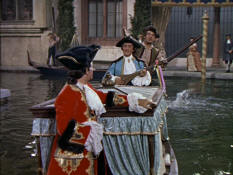 Pippo arrives in Venice singing a song while Lucio accompanies him. |
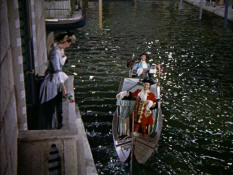 Thinking that Pippo is the real Casanova, the young ladies swoon. |
Casanova's Big Night opened in April 1954: April 7 in Los Angeles and April 17 in New York City. In 1954 the film grossed $3,500,000.
See Page Two for more pictures and reviews. See Page Three for pictures of posters, lobby cards and promo photos.
.
|
|
Casanova's Big Night is available on DVD
|
Images on this page are from the film "Casanova's
Big Night," copyright Paramount Pictures.







